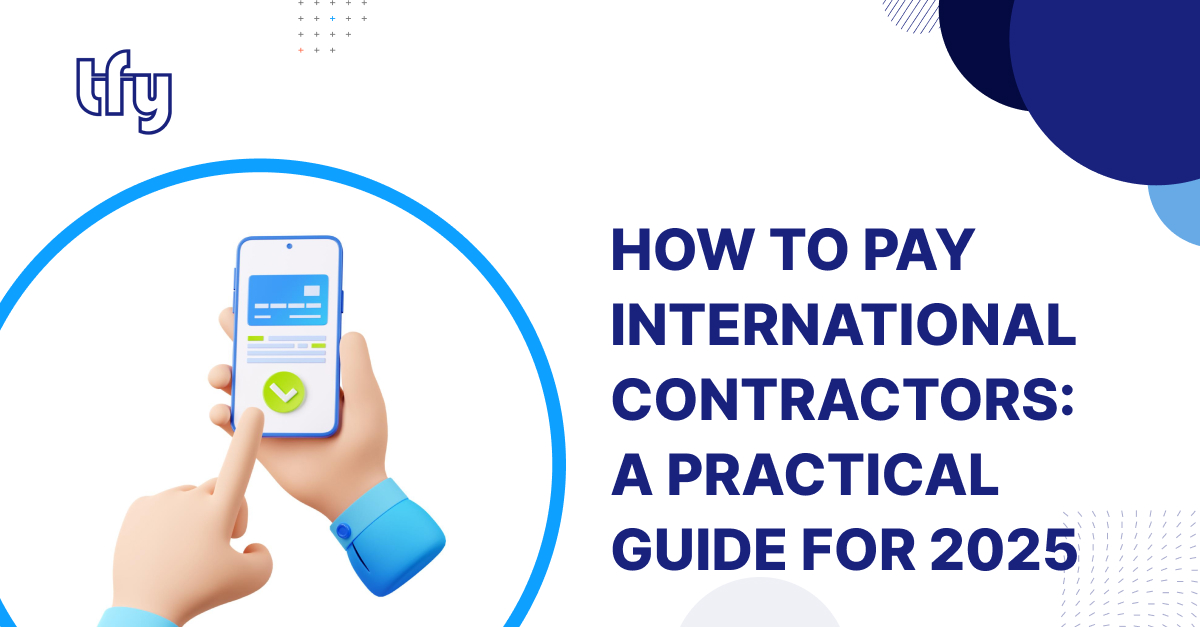
Hiring globally unlocks specialized skills and agility—but when it’s time to pay international contractors, cross-border rails, FX, tax rules, and misclassification risks kick in. This guide shows you how to pay correctly, on time, and compliantly—and where Transformify (TFY) simplifies everything.
What is an International Contractor?
A self-employed individual or entity in one country delivering services to a client in another, typically via fixed-term or project-based contracts. They manage their own taxes and benefits; you pay according to agreed terms.
The 3 biggest risks (and how to avoid them)
1) Compliance mistakes
Risk: Country-by-country rules (labor, tax, KYC/AML, data).
How to avoid: Standard contracts, KYC collection, and policy guardrails.
Pros & Cons of centralizing compliance
- Pros: Lower audit risk; faster onboarding; consistent records.
- Cons: Requires process discipline; may add upfront tooling cost.
2) Worker misclassification
Risk: “Contractor” in one country may be “employee” in another; penalties can include back pay and benefits.
How to avoid: Use checklists, local counsel, or EOR where appropriate.
EOR vs. Direct Contractor — Pros & Cons
Employer of Record (EOR)
- Pros: Local compliance handled; reduced misclassification risk; benefits/payroll managed.
- Cons: Per-worker fees; slightly less flexibility than pure contractor setup.
Direct Contractor
- Pros: Flexibility; lower ongoing cost; faster to engage.
- Cons: You own classification risk; more admin (contracts, tax forms).
3) Documentation gaps
Risk: Missing contracts, tax forms (e.g., W-8BEN/E), or payment proofs → audit headaches.
How to avoid: Keep a doc pack: SOW, IP/confidentiality, invoicing rules, tax forms, and payment receipts.
Pros & Cons of strict documentation
- Pros: Audit-ready; easier dispute resolution; faster renewals.
- Cons: Setup time; requires periodic refresh (e.g., expiring W-8s).
5 Ways to Pay International Contractors
1) Online payment platforms (e.g., Wise, PayPal, Payoneer)
Best for: Frequent payouts, many currencies, smaller to mid-sized invoices.
Pros
- Fast transfers and simple UX
- Multi-currency support with clearer FX than banks
- Easy reconciliation and contractor self-service
Cons
- Availability varies by country/currency
- Fees and FX spreads differ by rail
- Account verification/KYC may add initial friction
2) Freelance marketplaces (Upwork, Fiverr, Freelancer)
Best for: Short projects, trials, milestone-based work.
Pros
- Escrow and integrated contracts
- Built-in dispute management
- Quick start for one-off engagements
Cons
- Platform/service fees add up
- Communication rules; harder to build long-term vendor relationships
- Limited flexibility on invoicing terms
3) International bank transfers (SWIFT)
Best for: Larger or occasional invoices; contractors who require bank-to-bank.
Pros
- Ubiquitous reach; direct-to-account
- Strong traceability and remittance data
Cons
- Intermediary bank fees + FX markups
- Variable speed by corridor and compliance checks
- Heavier manual reconciliation if unmanaged
4) Checks / money orders
Best for: Edge cases with very limited digital access.
Pros
- Works where digital rails don’t
Cons
- Slow; loss/theft risk
- Higher processing/mailing costs
- Hard to track and reconcile
5) Cryptocurrency
Best for: Teams comfortable with on-chain flows or in regions with unstable banking.
Pros
- Near-instant settlement globally
- Potentially low network fees
Cons
- Price volatility; acceptance varies
- Tax reporting complexity; policy restrictions
- Wallet/custody and compliance overhead
Quick Comparison Breakdown
Method | Speed | Fees/FX | Coverage | Traceability | Best For |
| Online platforms | Fast | Competitive, variable | Broad | Good | Ongoing vendor payouts |
| Marketplaces | Fast post-milestone | Platform + FX | Global (platform) | Good (escrow) | Trials/short gigs |
| Bank (SWIFT) | Moderate→fast* | Bank + intermediary + FX | Global | Strong | Large/occasional |
| Checks/MOs | Slow | High | Global (postal) | Low | Edge cases |
| Crypto | Fast | Network + FX volatility | Growing | On-chain | Specialist cases |
U.S. tax paperwork for Foreign Contractors
- Collect W-8BEN (individuals) or W-8BEN-E (entities) to document foreign status/treaty claims.
- Services performed outside the U.S. are generally foreign-source (often no 1099); keep W-8 on file.
- Services performed in the U.S. by nonresidents may require withholding/reporting (e.g., 1042-S).
- Always confirm with your tax advisor for edge cases (hybrid work locations, treaty benefits, PE risk).
Pros & Cons of strict tax intake
- Pros: Reduces withholding/reporting errors; smooths audits.
- Cons: Requires periodic refreshes; contractor education time.
Onboarding International Contractors
- Signed contract/SOW (scope, deliverables, IP/confidentiality)
- Payment terms (rail, currency, frequency, fees allocation)
- Tax forms (W-8BEN/E) with refresh cadence
- Tooling/playbooks (Slack, PM, code repos, file-sharing)
- Time-zone norms (overlap hours, response SLAs)
Pros & Cons of structured onboarding
- Pros: Faster productivity; fewer disputes; consistent experience.
- Cons: Some upfront lift to build templates and train teams.
Common mistakes to avoid
- Misclassifying contractors as employees (or vice versa)
- Skipping contracts or writing vague SOWs
- Ignoring local tax/labor rules or treaties
- Paying in the wrong currency (unexpected FX loss for contractors)
- Late payments (retention risk)
- Not tracking milestones/deliverables (invites disputes)
How Transformify (TFY) makes it easy to Pay International Contractors
- Global payouts (multi-currency, consolidated reconciliation)
- Compliance guardrails (W-8 collection, document vault, audit logs)
- EOR when needed to mitigate misclassification risk
- Automated approvals & remittance data
- Clear contractor portal for invoices, status, and payout timing
Hiring international contractors is one of the best ways to build a flexible, competitive team. But paying them properly is just as important as finding the right talent. By choosing the right payment method, collecting the correct tax forms, and using platforms that handle compliance, you can unlock global talent—without legal stress or admin overload.
And if you need a partner to simplify global hiring? Transformify (TFY) is here to help you pay contractors the right way—every time.



